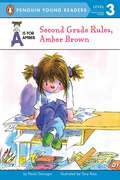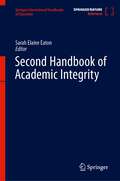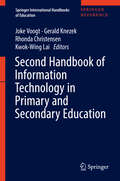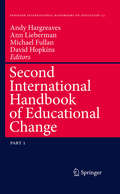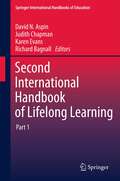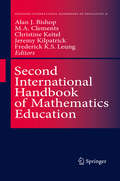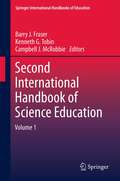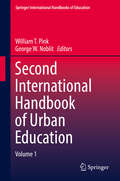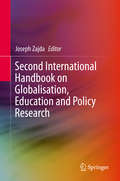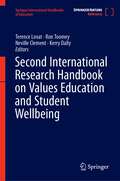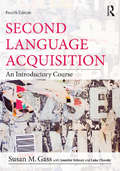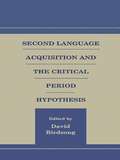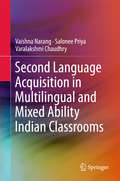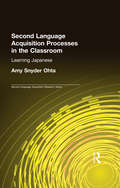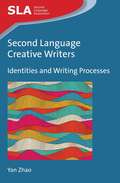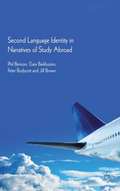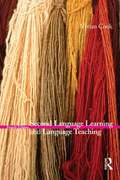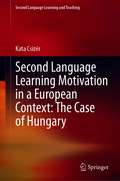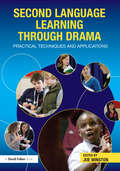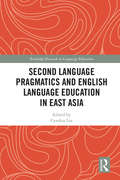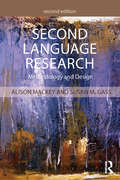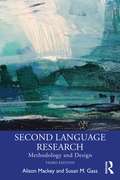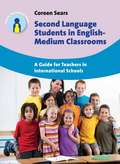- Table View
- List View
Second Grade Rules, Amber Brown (A Is for Amber #5)
by Paula DanzigerAmber Brown thinks that second grae rules! But when her teacher says desks have to be kept clean, Amber knows that is one rule she cannot follow. She desperately wants the desk fairy, Deskarina, to visit her desk and leave a reward. A messy desk never bothered Amber before, but now that a treat is involved, it does...Following closely on the events in Get Ready for Second Grade, Amber Brown, kids and teachers will applaud this hilarious take on a universal classroom issue.
Second Grade Rules, Amber Brown
by Paula DanzigerSecond grade is almost as wonderful as Amber expected, but there's one problem: the rules. Most of them are easy for Amber, but she just can't manage to keep her desk clean.
Second-grade Star
by Nancy Alberts[from the back cover] "No more boring old Kelly? Kelly has been waiting for the Spring Concert for weeks. This year it's going to be really special--some of the second graders will have a chance to be stars! That's when Kelly decides that, more than anything, she wants to be selected for a special part. But, no matter how hard she tries to impress her teacher, she isn't chosen. Now what? Well, Kelly soon realizes that sometimes being a star isn't all it's cracked up to be. And that she has her own way of shining just as brightly."
Second Handbook of Academic Integrity (Springer International Handbooks of Education)
by Sarah Elaine EatonThe book brings together diverse views from around the world and provides a comprehensive overview of academic integrity and how to create the ethical academy. At the same time, the Handbook does not shy away from some of the vigorous debates in the field such as the causes of academic integrity breaches. There has been an explosion of interest in academic integrity in the last 20-30 years. New technologies that have made it easier than ever for students to ‘cut and paste’, coupled with global media scandals of high profile researchers behaving badly, have resulted in the perception that plagiarism is ‘on the rise’. This, in combination with the massification and commercialisation of higher education, has resulted in a burgeoning interest in the importance of academic integrity, how to safeguard it and how to address breaches appropriately. What may have seemed like a relatively easy topic to address – students copying sources without attribution – has in fact, turned out to be a complex, interdisciplinary field of research requiring contributions from linguists, psychologists, social scientists, anthropologists, teaching and learning specialists, mathematicians, accountants, medical doctors, lawyers and philosophers, to name just a few.Because of this broad interest and input, this handbook serves as the single authoritative reference work which brings together the vast, growing, interdisciplinary and at times contradictory body of literature. For both established researchers/practitioners and those new to the field, this Handbook provides a one-stop-shop as well as a launching pad for new explorations and discussions.
Second Handbook of Information Technology in Primary and Secondary Education
by Joke Voogt Gerald Knezek Rhonda Christensen Kwok-Wing LaiIn this second edition the editors continue their efforts to synthesize research and practice and project future directions in the field of information and communication technology. The proliferation of mobile devices and applications have had major implications on how the nature of teaching and learning should be conceptualised, and what pedagogical practices should be used to support bridging formal and informal learning. The advent of social media also highlights the importance of gaining a deeper understanding of social learning theories and computer-supported collaborative learning theories and practices. The advancement of new technologies to support easy accessibility of educational resources such as OER and to a lesser extent MOOCs have led to the debate on how assessment should be conducted and how technologies could be used to support it. The demand of the knowledge society requires that researchers, policy makers, and educational practitioners be conversant with new research findings in order to understand the impact of ICT in teaching and learning, and how to support learners to use new technologies and applications creatively and effectively. New research paradigms have emerged to meet these challenges.
Second International Handbook of Educational Change
by Andy Hargreaves Ann Lieberman Michael Fullan David HopkinsThe two volumes of the second edition of the International Handbook of Educational Change comprise a totally new, and updated collection of the most critical and cutting-edge ideas in educational change. Written by the most influential thinkers in the field, these volumes cover educational change at both the theoretical and practical levels. The updated handbook remains connected to the classical concerns of the field, such as educational innovation, reform, and change management, and also offers new insights into educational change that have been brought about by social change and shifting contexts of educational reform. Like the first best selling Handbook, this one will also undoubtedly become an essential resource for people involved in all spheres of education, from classroom teachers, teacher leaders and administrators to educational researchers, curriculum developers, and university professors. No other work provides such a wide-ranging and comprehensive examination of the field of educational change.
Second International Handbook of Lifelong Learning
by Richard Bagnall David N. Aspin Judith Chapman Karen EvansThe second edition of the International Handbook of Lifelong Learning is extensive, innovative, and international in scope, remit and vision, inviting its readers to engage in a critical re-appraisal of the theme of "lifelong learning". It is a thorough-going, rigorous and scholarly work, with profound and wide-ranging implications for the future of educating institutions and agencies of all kinds in the conception, planning and delivery of lifelong learning initiatives. Lifelong learning requires a wholly new philosophy of learning, education and training, one that aims to facilitate a coherent set of links and pathways between work, school and education, and recognises the necessity for government to give incentives to industry and their employees so they can truly "invest" in lifelong learning. It is also a concept that is premised on the understanding of a learning society in which everyone, independent of race, creed or gender, is entitled to quality learning that is truly excellent. This book recognises the need for profound changes in education and for goals that are critically important to education, economic advancement, and social involvement. To those concerned about the future of our society, our economy and educational provision, this book provides a richly illuminating basis for powerful debate. Drawing extensively on policy analyses, conceptual thinking and examples of informed and world-standard practice in lifelong learning endeavours in the field, both editors and authors seek to focus readers' attention on the many issues and decisions that must be addressed if lifelong learning is to become a reality for us all.
Second International Handbook of Mathematics Education (Springer International Handbooks of Education #10)
by Alan J. BishopALAN 1. BISHOP The first International Handbook on Mathematics Education was published by Kluwer Academic Publishers in 1996. However, most of the writing for that handbook was done in 1995 and generally reflected the main research and development foci prior to 1994. There were four sections, 36 chapters, and some 150 people contributed to the final volume either as author, reviewer, editor, or critical friend. The task was a monumental one, attempting to cover the major research and practice developments in the international field of mathematics education as it appeared to the contributors in 1995. Inevitably there were certain omissions, some developments were only starting to emerge, and some literatures were only sketchy and speculative. However that Handbook has had to be reprinted three times, so it clearly fulfilled a need and I personally hope that it lived up to what I wrote in its Introduction: The Handbook thus attempts not merely to present a description of the international 'state-of-the-field', but also to offer synthetic and reflective overviews on the different directions being taken by the field, on the gaps existing in our present knowledge, on the current problems being faced, and on the future possibilities for development. (Bishop et aI. , 1996) Since that time there has been even more activity in our field, and now seems a good time to take stock again, to reflect on what has happened since 1995, and to create a second Handbook with the same overall goals.
Second International Handbook of Science Education
by Campbell J. Mcrobbie Barry J. Fraser Kenneth TobinThe International Handbook of Science Education is a two volume edition pertaining to the most significant issues in science education. It is a follow-up to the first Handbook, published in 1998, which is seen as the most authoritative resource ever produced in science education. The chapters in this edition are reviews of research in science education and retain the strong international flavor of the project. It covers the diverse theories and methods that have been a foundation for science education and continue to characterize this field. Each section contains a lead chapter that provides an overview and synthesis of the field and related chapters that provide a narrower focus on research and current thinking on the key issues in that field. Leading researchers from around the world have participated as authors and consultants to produce a resource that is comprehensive, detailed and up to date. The chapters provide the most recent and advanced thinking in science education making the Handbook again the most authoritative resource in science education.
Second International Handbook of Urban Education
by William T. Pink George W. NoblitThis second handbook offers all new content in which readers will find a thoughtful and measured interrogation of significant contemporary thinking and practice in urban education. Each chapter reflects contemporary cutting-edge issues in urban education as defined by their local context. One important theme that runs throughout this handbook is how urban is defined, and under what conditions the marginalized are served by the schools they attend. Schooling continues to hold a special place both as a means to achieve social mobility and as a mechanism for supporting the economy of nations. This second handbook focuses on factors such as social stratification, segmentation, segregation, racialization, urbanization, class formation and maintenance, and patriarchy. The central concern is to explore how equity plays out for those traditionally marginalized in urban schools in different locations around the globe. Researchers will find an analysis framework that will make the current practice and outcomes of urban education, and their alternatives, more transparent, and in turn this will lead to solutions that can help improve the life-options for students historically underserved by urban schools.
Second International Handbook on Globalisation, Education and Policy Research
by Joseph ZajdaThis handbook presents a global overview of developments in education and policy change during the last decade. It provides an accessible, practical and comparative source of current research that examines the intersecting and diverse discourses of this important issue. Divided into two parts, the handbook first examines globalisation and education policy reforms, including coverage of main trends as well as specific policy issues such as gender, equity, minorities and human rights. Next, the handbook offers a comparative perspective that evaluates the ambivalent and problematic relationship between globalisation, the state and education reforms globally. It features coverage on curricula issues and education reforms in schools around the world as well as the curriculum in the global culture. Now more than ever there is a need to understand and analyse both the intended and the unintended effects of globalisation on economic competitiveness, educational systems, the state and relevant policy changes--all as they affect individuals, the higher education sector, schools, policy-makers and powerful corporate organisations across the globe. By examining some of the major education policy issues, particularly in the light of recent shifts in education and policy research, this handbook offers readers a comprehensive picture of the impact of globalisation on education policy and reforms. It will serve as a vital sourcebook of ideas for researchers, practitioners and policy makers in education.
Second International Research Handbook on Values Education and Student Wellbeing (Springer International Handbooks of Education)
by Terence Lovat Ron Toomey Neville Clement Kerry DallyThis collection applies the principles underlying values education to addressing the many social and learning challenges that impinge on education today . Insights in the fields of social and emotional learning, student wellbeing, and, increasingly, educational neuroscience have demonstrated that values education represents an efficacious pedagogy with holistic effects on students across a range of measures, including social, emotional, and intellectual outcomes. With schools in the 21st century confronting issues such as gender identity, stemming radicalism, mental health, equity for disadvantaged groups, bullying, respect, and the meaning of consent, values education offers a way of teaching and learning that integrates and enhances student’s affective and cognitive functioning. The earlier edition of this book has become a standard reference for scholars and practitioners in the fields of values education, moral education, and character education. Its citation rates, reads and downloads have been consistently and enduringly high, as have those of its companion text, Values Pedagogy and Student Achievement. A decade on, the main purpose of the revised edition is to update and incorporate new research and practice relevant to values education. Recent insights in the fields of neuroscience and social and emotional learning and their implications for education and student wellbeing are more overt than they were when the first edition was being compiled. Additionally, advanced thinking in the field of epistemology, how humans come to know and therefore learn, has also sharpened, especially through the later writings of prominent scholars like Jurgen Habermas. The revised edition has preserved the essential spirit and thrust of the original edition while making space for some of these new insights about the potential of values education to establish optimal and harmonious learning and social environments for both students and teachers.
Second Language Acquisition: An Introductory Course
by Susan M. GassNow in a fourth edition, this bestselling introductory textbook remains the cornerstone volume for the study of second language acquisition (SLA). Its chapters have been fully updated, and reorganized where appropriate, to provide a comprehensive yet accessible overview of the field and its related disciplines. To reflect current developments, new sections on using learner corpora, semantics and morphosyntax (within formal approaches to SLA), sociocultural approaches, gesture, priming research, and chaos theory have been added. Students will also find expanded discussions of heritage language learning, bilingualism, pragmatics, and much more. The redesigned fourth edition of Second Language Acquisition retains the features that students found useful in the current edition but also provides new pedagogical tools that encourage students to reflect upon the experiences of second language learners. As with previous editions, discussion questions and problems at the end of each chapter help students apply their knowledge, and a glossary defines and reinforces must-know terminology. This clearly-written, comprehensive, and current textbook, by expert Sue Gass, is the ideal textbook for the introductory SLA course in second language studies, applied linguistics, linguistics, TESOL, and language education programs.
Second Language Acquisition and the Critical Period Hypothesis (Second Language Acquisition Research Series)
by David BirdsongSecond Language Acquisition and the Critical Period Hypothesis is the only book on the market to provide a diverse collection of perspectives, from experienced researchers, on the role of the Critical Period Hypothesis in second language acquisition. It is widely believed that age effects in both first and second language acquisition are developmental in nature, with native levels of attainment in both to be though possible only if learning began before the closure of a "window of opportunity" – a critical or sensitive period. These seven chapters explore this idea at length, with each contribution acting as an authoritative look at various domains of inquiry in second language acquisition, including syntax, morphology, phonetics/phonology, Universal Grammar, and neurofunctional factors. By presenting readers with an evenly-balanced take on the topic with viewpoints both for and against the Critical Period Hypothesis, this book is the ideal guide to understanding this critical body of research in SLA, for students and researchers in Applied Linguistics and Second Language Acquisition.
Second Language Acquisition in Multilingual and Mixed Ability Indian Classrooms
by Vaishna Narang Salonee Priya Varalakshmi ChaudhryThis book discusses current research on learning theories and pedagogical practices in second language acquisition, and tries to bridge the gap between the two. Second language acquisition is perceived as the study of the relationship between input, intake and output in a particular task performance, and Indian classrooms are the context for the research studies in this book. The empirical studies discussed in this book are based on two tasks: seminar speech task (SST) and written test performance task (WTPT). The pedagogical practices discussed cover three specific areas: tasks, skills, and strategies. The study focuses on text input processing for written versus spoken tasks, at various levels of task performance, and for language versus information. The authors discuss, among other issues, various elements of second language speech production, teachers' evaluation of communicative versus form-focused tasks, and task-based versus proficiency-based performance. As a study located in multilingual and mixed ability classrooms, this work provides immense insights to teacher-educators and researchers working in ESL settings with learners from diverse backgrounds.
Second Language Acquisition Processes in the Classroom: Learning Japanese (Second Language Acquisition Research Series)
by Amy Snyder OhtaThis book is the first study to examine how interactional style develops within the walls of a foreign language classroom in the first two years of language study. Results show learners to be highly sensitive to pragmatic information and that learners can move toward an appropriate interactional style through classroom interactive experience. The book shows how learners are most often sources who offer assistance and correction, with errors serving most often to stimulate further thinking about what form is correct. Analysis shows learners to be active in seeking corrective information in the classroom setting, not only from peer partners but also from the teacher. They are active in noticing how the teacher's utterances--even when addressed to others--contrast with their own, and utilize corrective feedback intended for other students. In addition, the results show that teacher-initiated corrective feedback addressed to individual learners is only one source of corrective feedback. Learners are shown to be active in both teacher-fronted and peer interactive settings. In newer L2 teaching methodologies which focus on the use of peer interactive tasks, the teacher's role has been de-emphasized. This book, however, shows how important the teacher's role is. The final chapter examines how the teacher can act to maximize the benefits of peer interactive tasks through how they design tasks and present them to the class. First, the chapter looks at how learners use English--their L1--in the classroom, concluding that how teachers present activities to the class has an impact on the amount of L1 used by students during peer interaction. Following up on this finding, the chapter works to address questions that teachers face in lesson planning and teaching. It presents a useful list of questions teachers can ask when designing peer interactive tasks in order to maximize the effectiveness of a wide variety of language learning tasks.
Second Language Creative Writers
by Yan ZhaoThis monograph investigates fifteen L2 creative writers' social constructive power in identity constructions. Through interviews and thinkaloud story writing sessions, the central study considers how L2 writer voices are mediated by the writers' autobiographical identities, namely, their sense of selves formulated by their previous language learning and literacy experiences. The inquiry takes the epistemological stance that L2 creative writing is simultaneously a cognitive construct and a social phenomenon and that these two are mutually inclusive. The study contributes to L2 creative writing research and L2 learner identity research and will be of benefit to researchers, language teachers and writing instructors who wish to understand creative writing processes in order to help develop their students' positive selfesteem, confidence, motivation and engagement with the L2.
Second Language Identity in Narratives of Study Abroad
by Phil Benson Et Al.Study abroad is now both an international industry and an experience that can have a deep impact on students' attitudes and approaches to second language learning. Narratives of Second Language Identity in Study Abroad brings together three important research areas by exploring the impact of study abroad on second language identities through narrative research. It outlines a new model of second language identity that incorporates a range of language and personal competencies. The three main dimensions of this model are explored in chapters that begin with students' study abroad narratives, followed by the authors' in-depth analysis. Further chapters use narratives to assess the impact of programme type and individual difference. Arguing that second language identity development is one of the more important outcomes of study abroad, the book concludes with recommendations on how study abroad programmes can best achieve this outcome.
Second Language Learning and Language Teaching
by Vivian CookThe fourth edition of this classic textbook has been revised to reflect recent developments in language teaching and learning yet retains the basic structure and approach so popular with its readers. Teaching and learning content has been updated, particularly taking into account the rise of task-based learning, Conversational Analysis and social models of second language acquisition, changes in national syllabuses and examinations and the increasing controversy over the role of the native speaker target. Each chapter has been revised to stand alone, enabling the text to be taught and studied out of sequence if preferred. A set of focusing questions has also been added to each and further reading sections have been updated. Second Language Learning and Language Teaching remains the essential textbook for all student teachers of modern languages and TESOL as well as applied linguistics.
Second Language Learning Motivation in a European Context: The Case of Hungary (Second Language Learning and Teaching)
by Kata CsizérThis book provides an overview of second language (L2) motivation research in a specific European context: Hungary, which has proved to offer an important laboratory for such research, as a number of major political changes over the past 30 years have created a changing background for L2 learning in an increasingly globalized world. The book provides an overview of theoretical research on L2 motivation, together with detailed information on large-scale L2 motivation studies in Hungary. Further, it presents a meta-analysis of the most important investigations, and qualitative data on teachers’ views regarding success in L2 learning. In turn, the interdisciplinary nature of L2 motivation is taken into account and relevant antecedent constructs to L2 motivation are investigated. Lastly, the book outlines possible future directions for L2 motivation research.
Second Language Learning through Drama: Practical Techniques and Applications
by Joe WinstonDrama is increasingly being recognised as a valuable pedagogy for language learning as it can harness children‘s imaginations and stimulate their desire to communicate. Second Learning Language through Drama draws on current theories of additional and foreign language learning and illustrates through practical case studies how drama can be used to support the four key skills of listening, speaking, reading and writing. Drawing on the work of an international group of practitioners who are all highly experienced in using drama for the purpose of second language learning, the book clearly explains key drama conventions and strategies and outlines the innovative ways they have been used to create enjoyable and stimulating classroom activities that allow for multiple ways of learning. Throughout the book the emphasis is on making language learning accessible and relevant to children and young people through creative, physically active and playful approaches. The strategies described are all highly flexible and readily adaptable to different teaching contexts. Specific themes include: Using stories and drama to motivate learners at all levels Drama, language learning and identity Assessment opportunities through process drama Issues of language learning and cultural empowerment Digital storytelling Film & drama aesthetics Second Language Learning through Drama will be of great interest to those studying on undergraduate and postgraduate courses and will serve as a highly valuable text to practitioners looking to incorporate the approaches described into their lessons and classroom activities.
Second Language Pragmatics and English Language Education in East Asia (Routledge Research in Language Education)
by Cynthia LeeThis edited collection addresses the link between second language pragmatics (including interlanguage and intercultural) research and English language education. The chapters use different contemporary research methods and theoretical frameworks such as conversation analysis, language-learners-as-ethnographers, discourse and interactional approaches and data in contexts (either in the region or overseas). The content explores and discusses the significance of learning and teaching of second language (L2) pragmatics in language education for learners who use English as a lingua franca for academic and intercultural communication purposes with native and non-native speakers of English, focusing on pragmatic actions, social behaviours, perceptions and awareness levels in three regions in East Asia – China, Japan and South Korea. It is an important contribution to the area of second language pragmatics in language education for East Asian learners. It recommends research-informed pedagogies for the learning and teaching of interlanguage or intercultural pragmatics in regions and places where similar cultural beliefs or practices are found. This is an essential read for researchers, language educators, classroom teachers, readers who are interested in second language pragmatics research and those interested in second language acquisition and English language education in the East Asian context.
Second Language Research: Methodology and Design
by Alison Mackey Susan M. GassIn this second edition of the best-selling Second Language Research, Alison Mackey and Sue Gass continue to guide students step-by-step through conducting the second language research process with a clear and comprehensive overview of the core issues in second language research. Supported by a wealth of data examples from actual studies, the book examines questions of what is meant by research and what defines good research questions, covering such topics as basic research principles and data collection methods, designing a quantitative research study, and concluding and reporting research findings. The second edition includes a new chapter on mixed-methods, new "time to think" and "time to do" text boxes throughout, and updates to reflect the latest research and literature. Supplementary materials, including an extensive glossary and appendices of forms and documents that students can use in conducting their own studies, serve as useful reference tools, with suggestions on how to get research published reemphasizing the book’s practical how-to approach. Second Language Research, Second Edition is the ideal resource for understanding the second language research process for graduate students in Second Language Acquisition and Applied Linguistics.
Second Language Research: Methodology and Design
by Alison Mackey Susan M. GassSecond Language Research: Methodology and Design is a clear, comprehensive overview of core issues in L2 research. Authored by well-known scholars in SLA and supported by a wealth of examples from actual studies and extensive pedagogical resources, this book first introduces students to the key topics and debates in L2 research. It then guides readers step by step through the research process—from basic principles and collection methods through study design and reporting—to the point of being able to conduct their own research from beginning to end. This book is an essential text for students and novice researchers of SLA, applied linguistics, and second and foreign language teaching. Key Features A wealth of graphics, visuals, and exercises in each chapter. "Time to Think" and "Time to Do" boxes within chapters Helpful glossary and subject index New to This Edition Substantially reorganized chapters Significantly expanded chapters on qualitative and mixed methods Substantive revised material on computer/technology-based research Spotlights a variety of new software packages and databases, including video-mediated technology and games Discusses the Open Science Movement Expanded coverage of corpora, processing, and psycholinguistics-based research Updated references throughout
Second Language Students in English-Medium Classrooms
by Coreen SearsSecond Language Students in English-Medium Classrooms offers a real-life practical guide to teachers that will enable them to serve students from many linguistic and cultural backgrounds effectively. Written in an accessible manner it includes numerous exemplary strategies and resources as well as practical references to the latest uses of embedded technology. All of these are designed to reflect contemporary practice in international schools. The book also tackles the controversial and politically-charged issues of the potentially overwhelming impact of English in global contexts and the use of students' mother-tongues in English-medium classrooms. Written by an author and researcher with over 35 years' experience, this book is an essential resource for all teachers, administrators and parents of children in international schools.
